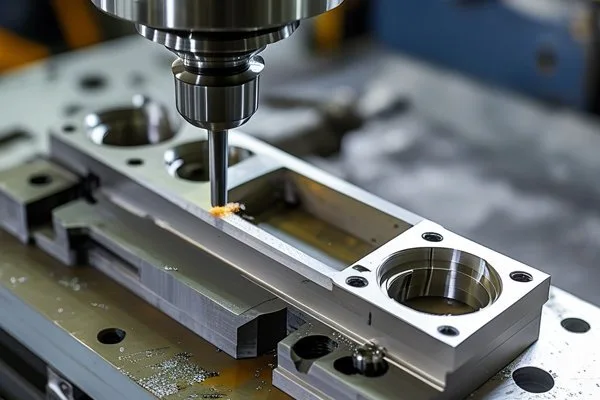Have you ever looked at a finely machined aluminum part and marveled at its shiny surface? Or perhaps, you’ve wondered why some parts appear smoother than others despite being made of the same material? In the world of CNC (Computer Numerical Control) machining, achieving the right surface finish is like perfecting a recipe: it requires the right ingredients, precise measurements, and a sprinkle of creativity.
Welcome to this deep dive where we’ll unravel the art of optimizing CNC machining paths specifically for aluminum parts to achieve RA (Roughness Average) values of 0.8 and 0.
What is CNC Machining, and Why Does Surface Finish Matter?
First things first, let’s demystify what CNC machining is all about. Imagine a really smart robot arm that you instruct to cut, carve, and shape various materials based on a computer program. That’s CNC machining in a nutshell. It’s widely used in industries ranging from aerospace to healthcare, and one of the crucial factors in determining the quality of CNC machined components is surface finish.
The Importance of Surface Finish
Why should you care about surface finish? Well, it’s not just about aesthetics. The surface finish of a component can affect friction, wear resistance, and even how well it can handle extreme pressures. Think of surface finish like the skin of an apple: a smooth skin means it’s likely fresher, while a rough, blemished one indicates potential issues underneath.
In the case of aluminum parts, achieving a smooth surface finish enhances their performance, increases durability, and promotes better bonding or adhesion properties when coatings or treatments are applied.
Understanding RA Values: What Do They Mean?
You might be wondering, what is RA 0.8 and RA 0.6 exactly? In simple terms, RA values quantify the roughness of a surface. The lower the RA value, the smoother the surface.
Achieving these values can feel like trying to hit a bullseye – it takes patience, practice, and precision.
The Role of CNC Machining Paths in Achieving Surface Finish
Now that we’ve set the stage, let’s talk about the heart of our discussion: CNC machining paths. Think of these paths like the route map for a road trip. If you take the wrong turn or drive too fast, you might not reach your destination smoothly.
Factors Influencing CNC Machining Paths
Several factors come into play when optimizing CNC machining paths for achieving that desired RA finish:
Let’s dive deeper into each of these factors!
Tool Selection: Your Secret Weapon
Just like a chef chooses the best knife for slicing, selecting the right CNC tool is essential for achieving the desired surface finish. Generally, carbide tools are preferred for aluminum due to their hardness and ability to maintain a sharp edge, which translates to better surface quality.
What to Consider When Choosing Tools:
Feed Rate: The Balancing Act
The feed rate is the rate at which the tool moves through the material. An optimal feed rate must balance speed and surface quality.
Spindle Speed: The Power Behind Precision
Spindle speed plays a vital role in surface finish quality. Higher spindle speeds lead to a better surface finish but must be carefully managed to avoid excessive heat.
Tips for Spindle Speed Optimization:

Cutting Depth: The Art of the Shallow Cut
When it comes to CNC machining, remember the saying “less is more.” Shallow cuts generally promote smoother finishes due to reduced tool deflection and less abrasive interaction with the material.
Tool Path Strategy: The Route to Smoothness
The way a CNC tool moves across the workpiece significantly influences the achieved surface finish.
Consider These Strategies:
Simulation and Testing: Your CNC Crystal Ball
Okay, so we’ve discussed the elements influencing CNC machining paths, but how can you be confident in your choices? Enter simulation software.
Simulation tools allow you to visualize the machining process before it even begins. You can see how the tool interacts with the material and make real-time adjustments to paths, speeds, and depths before cutting into your precious aluminum.
Conducting Test Cuts
Even after simulations, running test cuts is crucial. These small-scale prototypes give you tangible results that may differ from software predictions.
Post-Processing Techniques to Enhance Surface Finish
After milling, a few post-processing techniques can elevate your surface finish.
Polishing
Polishing can significantly improve surface finish. Whether using wet or dry polishing processes, this step is essential for achieving enhanced RA values.
Anodizing
By anodizing aluminum, you not only improve corrosion resistance but can also enhance surface smoothness. It’s like giving your part a coat of armor while also making it more attractive.
Coating
Applying coatings can minimize surface roughness, improve wear properties, and enhance the visual appeal.
Key Takeaways: Your Blueprint for Success
Congratulations! You’ve now ventured through the intricate world of optimizing CNC machining paths for aluminum parts. Here’s a handy list of key takeaways to remember:
Achieving RA values of 0.8 and 0.6 may feel daunting, but with the right strategies and finesse, you can produce parts that shine both in quality and appearance.
So, are you ready to upgrade your CNC machining game? Your journey toward impeccable surface finish starts now!





